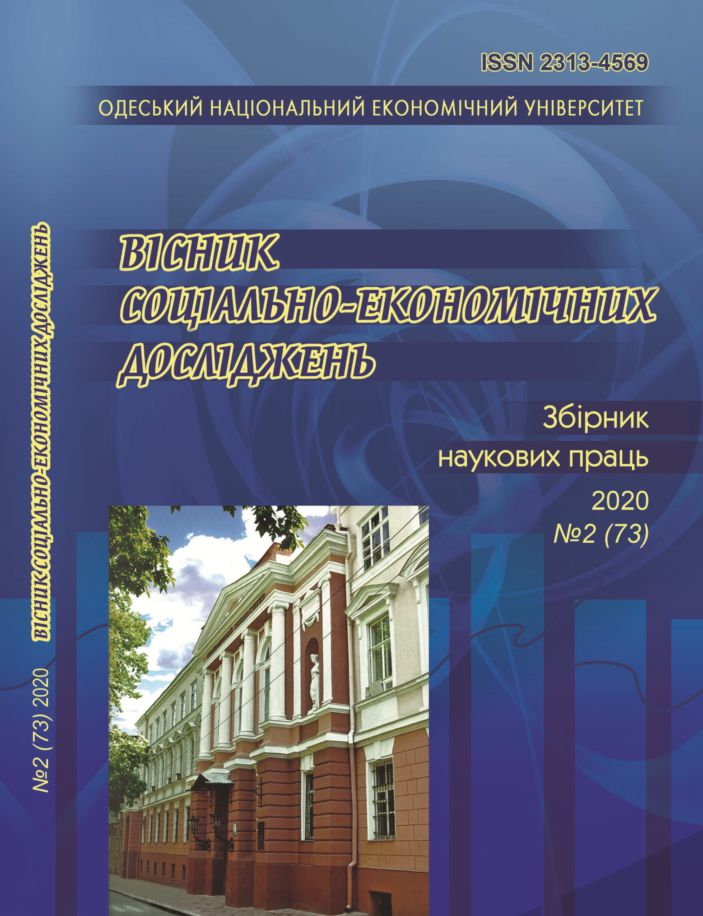Methodical approach to the selection of strategic alliance partners based on fuzzy logic
DOI:
https://doi.org/10.33987/vsed.2(73).2020.121-135Keywords:
strategic business alliance, strategic interaction, synergy potential, fuzzy logic, fuzzy multi-criteria analysis, linguistic variables, term set, Fuzzy SAW, Fuzzy VIKORAbstract
The article develops a methodical approach to the choice of partners in the strategic alliances formation with a tools using of fuzzy set theory. The necessity of taking into account for potential strategic partners analyzing not only assessments of their current state (strengths and weaknesses, financial capacity, competitive advantages), but also the forecast effectiveness of further cooperation, is substantiated. Accordingly, it was noted that the partners selection for the strategic alliance, in addition to the use of traditional financial instruments (cost-benefit analysis, which focuses on the balance of profits and losses from business operations) and criteria, should take into account the synergy potential in areas of possible interaction and cooperation, should be an element of enterprise development strategy and to agree with the strategic goals and corporate values of the enterprise. The methods of strategic diagnostics and fuzzy methods of multicriteria analysis are used in the work to achieve the set goals. The proposed model takes into account the criteria for assessing the synergy potential by F. Evans and D. Bishop (size of benefits from synergistic effect, probability of success, time to receive benefits). The study determines the areas of strategic interaction, each of which is divided into areas of potential cooperation by decomposition. Fuzzy numbers in triangular form with triangular membership functions are used to present linguistic estimates of experts. The Fuzzy SAW method is used to determine the fuzzy weights of the interaction and possible cooperation areas, and the Fuzzy VIKOR method is used to rank potential partners. This methodological approach can be used in strategic management of enterprises in order to form and implement a strategy of strategic alliances creating to eliminate gaps in their own value chain and strengthen existing or obtaining the desired competitive advantages in the market.
References
Druker, P. (2004). Encyclopedia of management. Trans. from Eng. [Entsiklopediya menedzhmenta; per. s angl.], Vilyams, Moskva, 432 s. [in Russian]
Trendsetter Barometer PWC. Retrieved from: https://www.pwc.com/us/en/private-companyservices/publications/assets/pwc-trendsetter-barometer-q4-2018-chart-pack.pdf.
Dussage, P., Garrett, B., Mitchell, W. (2000). Learning from competing partners: Outcomes and durations of scale and link alliances in Europe, North America, and Asia. Strategic Management Journal, No. 21, pp. 99–126.
Wallace, R. L. (2005). Strategic partnerships: an entrepreneur’s guide to joint ventures and alliances. Trans. from Eng. [Strategicheskie alyansy v biznese. Tekhnologii postroeniya dolgosrochnykh partnerskikh otnosheniy i sozdaniya sovmestnykh predpriyatiy; per. s angl.], Dobraya kniga, Moskva, 288 s. [in Russian]
Faulkner, D. О. (1995). International strategic alliances. Co-operation to compete. London, McGraw-Hill Companies, 221 р.
Ansoff, I. (1989). Strategic management [Strategicheskoe upravlenie], Ekonomika, Moskva, 519 s. [in Russian]
Pidhurska, I. A. (2011). Strategic guidelines for international alliances formation of Ukrainian enterprises [Stratehichni oriientyry formuvannia mizhnarodnykh aliansiv ukrainskykh pidpryiemstv], Naukovyi visnyk Uzhhorodskoho universytetu, Seriia: Ekonomika, Vyp. 2 (34), s. 197–202 [in Ukrainian]
Maksуmenko, I. Ya., Yefimova, M. O. (2019). Features of strategic alliances formation in international and Ukraine markets [Osoblyvosti formuvannia stratehichnykh aliansiv na mizhnarodnomu ta ukrainskomu rynkakh], Efektyvna ekonomika, No. 12. Retrieved from: http://www.economy.nayka.com.ua/?op=1&z=7485 [in Ukrainian]
Kharlamova, G., Balan, V., Kukhta, P. (2016). Partner choice multi-criteria model at the strategic business alliances forming. Revista Economică, 68:1, pp. 103–124.
Chang, M.-H., Liou, J. H., Lo, H.-W. (2019). A Hybrid MCDM Model for Evaluating Strategic Alliance Partners in the Green Biopharmaceutical Industry. Sustainability, 11, 4065, pp. 1–20. DOI: https://doi.org/10.3390/su11154065.
Liou, J. J. H. (2012). Developing an integrated model for the selection of strategic alliance partners in the airline industry. Knowledge-Based Systems, No. 28, pp. 59–67.
Akhavan, P., Barak, S., Maghsoudlou, H., Antuchevičienė, J. (2015). FQSPM-SWOT for strategic alliance planning and partner selection; case study in a holding car manufacturer company. Technological and economic development of economy, Vol. 21 (2), pp. 165–185.
Hrebeshkova, O. M. (2008). Problems of identifying and evaluating the synergistic effect of enterprises strategic interaction [Problemy vyiavlennia ta otsinky synerhiinoho efektu stratehichnoi vzaiemodii pidpryiemstv], Formuvannia rynkovoi ekonomiky. Spets. vyp. Ekonomika pidpryiemstva: teoriia i praktyka. KNEU, Kyiv, T. 1, s. 162–169 [in Ukrainian]
Evans, F. C., Bishop, D. M. (2002). Valuation for M&A: Building Value in Private Companies. John Wiley & Sons Inc., 312 p.
Chen, C. T. (2000). Extensions of the TOPSIS for group decision-making under fuzzy environment. Fuzzy Sets and Systems, Vol. 114, pp. 1–9.
Opricovic, S. (2011). Fuzzy VIKOR with an application to water resources planning. Expert Systems with Applications, Vol. 38, No. 10, pp. 12983–12990.
Sirower, M. (2000). The synergy trap: how companies lose the acquisition game. The Free Press, New York, 237 p.
Downloads
Published
Issue
Section
License
Copyright (c) 2020 Socio-Economic Research Bulletin

This work is licensed under a Creative Commons Attribution 4.0 International License.






